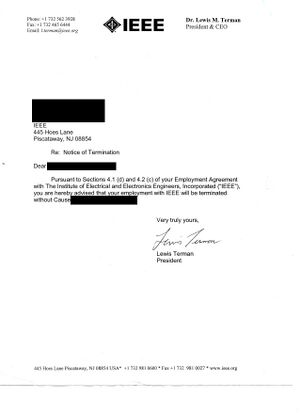First-Hand:Who Is In Charge of IEEE?
By John Vig - An account of the termination of an executive director by the IEEE Board of Directors.
IEEE is undoubtedly a volunteer-led organization but, occasionally, some cynics claim that staff is really in charge. Really?
IEEE has slightly more than 1,000 employees, "the staff," who report to an executive director (ED), who is appointed by the IEEE Board of Directors (BoD). The ED serves at the pleasure of the BoD. All it takes to terminate the ED is a simple majority vote of the BoD. One indication that staff is subordinate to the BoD is that, on several occasions in IEEE's history, the BoD did terminate the ED.
One termination took place in 2008 when Lew Terman was president and I was president-elect (PE). A director made a motion (in an executive session of the BoD) to terminate the then ED. The IEEE's attorney, Bob Dwyer, was asked to help to make sure that everything took place properly. After an extensive discussion, the BoD passed the motion.
The next day, Dwyer prepared the attached Notice of Termination, and Terman and I delivered the notice to the ED. (As the president, it was Terman who handed the letter to the ED.) Only a few words were exchanged before we left the ED's office. We gave the ED more than a week to "clean out his office." The BoD appointed no acting ED. The 3P's (president, PE and past-president), together with senior staff, acted as an informal acting ED. This worked smoothly - for nearly a year.
Shortly thereafter, the BoD appointed a search committee consisting of the 3P's, the TAB Treasurer, and a few other "important" people, such as other past presidents. IEEE also hired an executive search firm. Initially, Terman chaired the search committee. After Jan 1, 2009 (when I became president), I chaired the committee.
The search firm proposed 12 candidates. The search committee narrowed the group to six candidates to be interviewed in person. On paper, each of the six seemed to be a strong, highly qualified candidate. We spent a full day interviewing and discussing the candidates - it was a long day! At the end of the day, each committee member gave each candidate a rating. Each committee member gave the same candidate the highest rating so, we had a clear winner, who had great qualifications on paper and was also excellent in the way he answered our questions
The BoD accepted our recommendation and assigned me to negotiate a compensation package. They authorized me to negotiate a salary in the range US$ 600K to 900K, plus benefits. The range was guided by the results of a comparability study. (What is the compensation of other executives in similar positions in similar non-profit as well as profit-making organizations?) The candidate and I negotiated (one-on-one, sitting in a quiet hotel lobby). For those interested, the compensation was, and is, public information. The compensation of the 10 highest paid IEEE employees is available in IEEE's Tax Form 990, required by U.S. law to maintain IEEE’s 501(c)(3) status. The most recent three years are posted on the IEEE website and previous years can be found on various charity navigator sites.
So, I hope that, if the question of who is in charge of IEEE ever comes up again, this bit of history will help settle the question.
